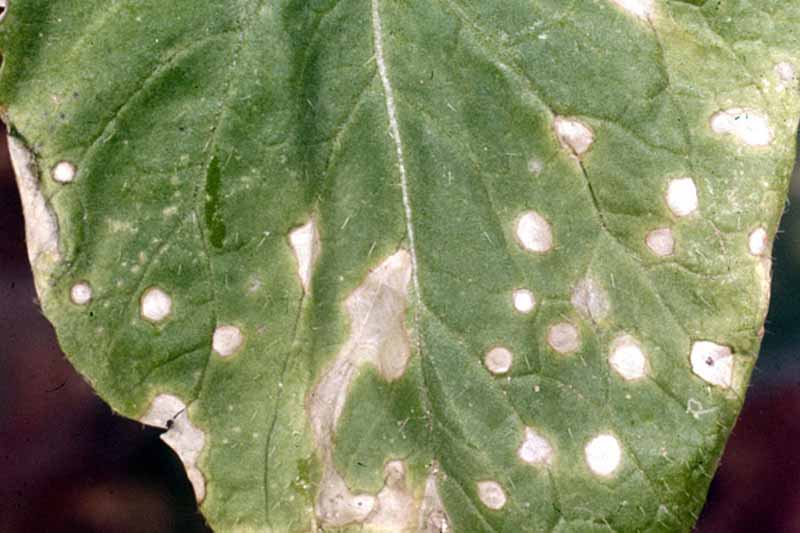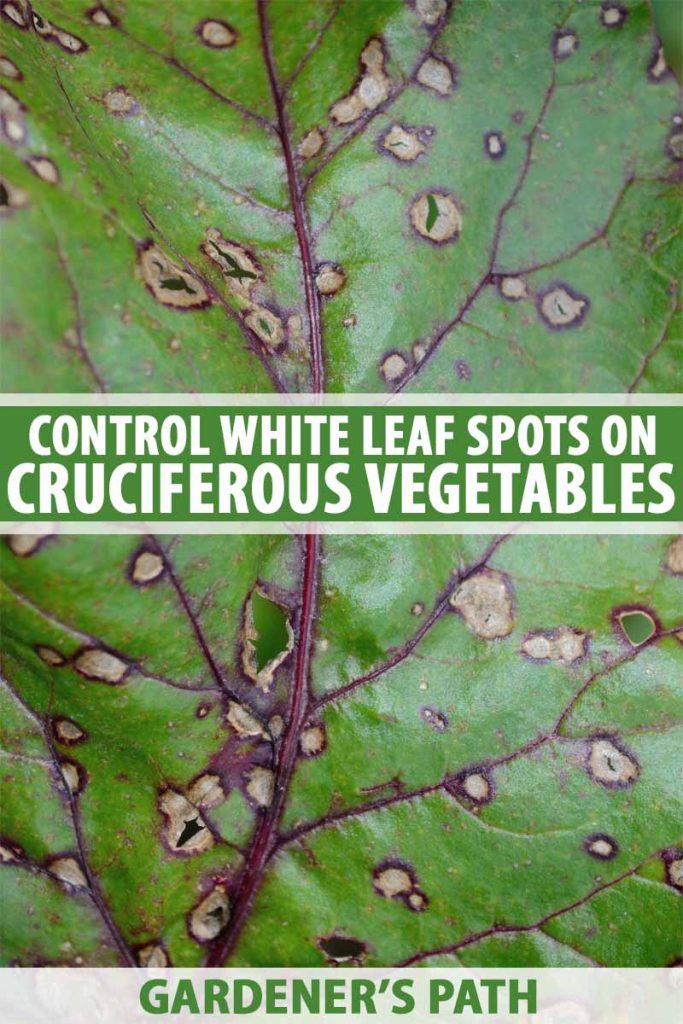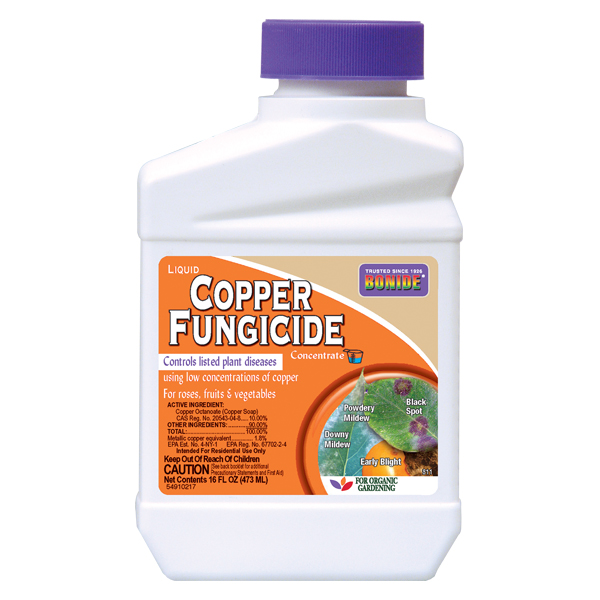Cercospora / Pseudocercosporella
While the fungi Cercospora or Pseudocercosporella that cause white spot can severely affect turnip, rutabaga, canola, mustard, radish, horseradish, and hybrids of turnips and mustard, they are much less likely to affect kale, collards, broccoli, or cauliflower.
This is a cool weather disease and is most likely to strike at 55 to 65 F.
The disease has been a particular problem on canola plants in Europe with pod losses of up to 15%.

We link to vendors to help you find relevant products. If you buy from one of our links, we may earn a commission.
Cultural treatments are the best way to control this disease, and the discussion below will walk you through the symptoms, life cycle, and control measures of white spot disease on crucifers.
What You’ll Learn
Symptoms
White spot disease gets its name from the circular white spots that are scattered over the leaves, stems, or pods of infected plants. Older spots may develop dark borders, and the centers may fall out. Such lesions look like shot holes.

In addition to turning yellow, leaves that are severely affected dry out and wither, although they remain attached to the plants.
Lesions on the stems are superficial with a distinct boundary between tissue that is diseased or healthy. The lesions start out brown and then turn ash-gray to white. Large numbers of tiny dark specks form in the lesions, which are known as gray stem.
Infected seed pods start out with small brown spots. They then expand and become grayish-white with dark spots inside.
Cool Moist Conditions Favor Disease Development
The remains of infected plants are a significant source of spores to spread the disease. The wind can spread the sexual spores long distances in the fall if the weather is moist following rain or dew and the temperatures are 55 to 65 F.
Rain or splashing water spread asexual spores in the late fall that can cause disease the following spring.
The fungus can overwinter in volunteer crop plants or in susceptible weeds like wild mustard, wild radish, and shepherd’s purse.
Cultural Controls
Prevention is the best bet to control white spot of crucifers. Purge susceptible weeds and any volunteer crucifers that are growing near your crop.
At the end of the season, remove the plant debris or plow it deeply into the soil.
Rotate your crops and avoid growing any brassicas in the immediatel area for three years.
Don’t plant cole crops in or near an area that was infected during the previous season.
Promoting good soil drainage will also help to protect against this infection.
Liquid Copper Treatment
You can apply liquid copper (a solution certfified organic) to your cole crops to control white spot fungus.
BONIDE® Liquid Copper Fungicide via Arbico Organics
Spray all the plant as soon as you see the disease. Be sure and spray the tops and bottoms of the leaves, and spray again every 7-10 days.
Fungicide Treatment
As soon as you see the white spot symptoms, you can apply the fungicide Benlate to the plants. This fungicide is a 50% solution of the compound benomyl. Benlate can be toxic to some crucifers, especially cabbage.
White Spot Fungi Infects Some Crucifers and Not Others
While these fungi do not typically infect kale, collards, cauliflower or broccoli, they do affect a range of cruciferous vegetables. They have been severe pathogens of canola in Europe.
White spot fungi prefer cool temperatures and frequently overwinter on volunteer crucifers, susceptible weeds, or in plant tissue.

While liquid copper is an option, prevention is usually the best way to control this disease.
Have you done battle with white spot fungus on your crucifer plants? If so, let us know your plants fared in the comments.
If you are still trying to identify a particular disease on your cole crops, you might try one of our other guides such as:
© Ask the Experts, LLC. ALL RIGHTS RESERVED. See our TOS for more details. Product photo via Bonide. Uncredited photos: Shutterstock.


I have small perfectly rounded whitish silver spots that appeared all over my entire petunia plants. Today they are all over my tomato seedlings. Just sad, I was beginning to harden off my plants prior to planting. What is this? Have never had a blemish or bug on plants I have grown before.
Hi Peggy, I’m so sorry to hear that your petunias and tomatoes are afflicted. It’s hard for me to figure out what the problem is without seeing it. Could you possibly post pictures?
I will get you some pictures tomorrow. It is not powdery mildew. I recognize that. I sprayed with Safer soap but not so sure what I am dealing with.
Hi Helga. Tell me about marigold curling leaves… I think that is just caused from viruses, but I’m not sure.
Leaf curl in plants like marigolds can be the result of a viral infection, but you will typically notice other symptoms as well. Curling leaves can also be the result of a pest infestation, irregular or inadequate irrigation, and other issues. One virus in particular that may affect marigolds as well as other common garden plants including tomatoes is Ageratum enation virus (AEV). Weeds serve as hosts for this virus, and it may be transmitted by whiteflies. See our guides to growing marigolds for more information that you may find useful.
Hi, my indoor tomato and basil plants seem to have this problem, is the copper a good option to help my plants?
Hi Jennifer,
Your poor tomato plants! Copper is a good treatment for fungal and bacterial diseases, although it doesn’t always treat all of the diseases out there.
Since your plants are inside, I would suggest neem oil. It kills bacteria and fungi. Since I’m not sure which is the culprit, and this is a very safe treatment to use, I think it’s a good choice to treat your plants that are indoors.
If you have a moment, let us know how well it works for you.
Hi Helga, I’m Kent from Hong Kong. I work in an indoor farm. Our Microgreen and Babygreen are suffering from infection. Is it the White Leaf Spot Disease?
Attached photos of our crops. Many thanks!
It may be, you’re wise to be concerned! Seeing as how important these crops are, I’d double-check with a local expert who can get eyes on your plants, test them, and give you a more definitive answer.
Apricot leaves white spot , what type of spray needed?
You can try neem oil or copper fungicide. If you’d like to post a picture of the leaves we can have a look and advise you further.
my bok choi (pak choi) got some white spots on leaves which turn black and the leaf dry